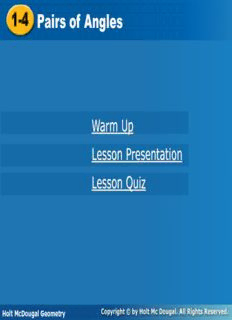
1-4 Pairs of Angles 1-4 Pairs of Angles PDF
Preview 1-4 Pairs of Angles 1-4 Pairs of Angles
1-4 Pairs of Angles 1-4 Pairs of Angles Warm Up Lesson Presentation Lesson Quiz HHooHllott lMMt GccDDeooomuuggeaatllr yGG eeoommeettrryy 1-4 Pairs of Angles Warm Up Simplify each expression. 1. 90 – (x + 20) 70 – x 2. 180 – (3x – 10) 190 – 3x Write an algebraic expression for each of the following. 3. 4 more than twice a number 2n + 4 4. 6 less than half a number Holt McDougal Geometry 1-4 Pairs of Angles Objectives Identify adjacent, vertical, complementary, and supplementary angles. Find measures of pairs of angles. Holt McDougal Geometry 1-4 Pairs of Angles Vocabulary adjacent angles linear pair complementary angles supplementary angles vertical angles Holt McDougal Geometry 1-4 Pairs of Angles Many pairs of angles have special relationships. Some relationships are because of the measurements of the angles in the pair. Other relationships are because of the positions of the angles in the pair. Holt McDougal Geometry 1-4 Pairs of Angles Holt McDougal Geometry 1-4 Pairs of Angles Example 1A: Identifying Angle Pairs Tell whether the angles are only adjacent, adjacent and form a linear pair, or not adjacent. AEB and BED AEB and BED have a common vertex, E, a common side, EB, and no common interior points. Their noncommon sides, EA and ED, are opposite rays. Therefore, AEB and BED are adjacent angles and form a linear pair. Holt McDougal Geometry 1-4 Pairs of Angles Example 1B: Identifying Angle Pairs Tell whether the angles are only adjacent, adjacent and form a linear pair, or not adjacent. AEB and BEC AEB and BEC have a common vertex, E, a common side, EB, and no common interior points. Therefore, AEB and BEC are only adjacent angles. Holt McDougal Geometry 1-4 Pairs of Angles Example 1C: Identifying Angle Pairs Tell whether the angles are only adjacent, adjacent and form a linear pair, or not adjacent. DEC and AEB DEC and AEB share E but do not have a common side, so DEC and AEB are not adjacent angles. Holt McDougal Geometry 1-4 Pairs of Angles Check It Out! Example 1a Tell whether the angles are only adjacent, adjacent and form a linear pair, or not adjacent. 5 and 6 5 and 6 are adjacent angles. Their noncommon sides, EA and ED, are opposite rays, so 5 and 6 also form a linear pair. Holt McDougal Geometry
Description: